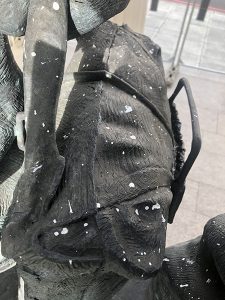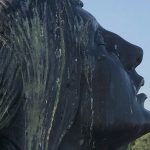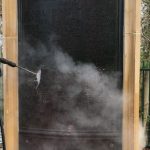The Vandalism of the Bomber Command War Memorial

Cleaning of this iconic War Memorial and restoration was necessary after white gloss paint was thrown over The Bomber Command War Memorial in Green Park earlier this year.
Conservation work by Antique Bronze took place some weeks later after the memorial was initially hit.
The monument is a magnificent creation by sculptor, Philip Jackson, who won the Marsh Award in Public Sculpture for his work. It’s easy to see why: the artist has personified bravery, comradeship and patriotism in the stance of his figures, their detail and expressions. We enjoyed many conversations with the public who came to visit the memorial during our works.
Why This War Memorial Is Special
Several of the visitors had interesting facts to tell us about the Bomber Command unit which was instrumental in winning World War II. Of the 125k men who served, half lost their lives. Bomber command crews came from 60 different countries. Every member was a volunteer. The average age of those killed was 23 years old.
Hours after the monument was vandalised, an emergency clean was undertaken. It was then that the RAF Benevolent Fund was advised that a monument cleaning service specialising in conservation should take on the due to complexities of working on bronze.
Removing the remnants of white paint from the bronze’s surface was not an easy task. Although much of the paint had been taken off in the initial clean, thousands of smaller splashes remained.
 Vandalism of Bomber Command War Memorial, Green Park
Vandalism of Bomber Command War Memorial, Green Park
The surface of the sculpture had originally been hot patinated, but areas were fragile. Before the treatment was started, we noted that there was evidence of localised loss of original patina. This meant that to avoid further loss of the surface, the cleaning technique decided upon had to be very gentle indeed.
 An area of loss of original patina
An area of loss of original patina
The aim of bronze conservation is always to leave as much of the original patina intact as possible.
Another difficulty was that the surface was highly detailed meaning that many of the tiny splashes were located deep inside small grooves making them hard to excavate.
It may seem like superheated water or high-pressure cleaning may be an obvious option for this type of vandalism, but the fragility of the patina made this route a concern. The paint was so firmly adhered to the textured surface that to shift it, force would have to be centred on a very tiny surface area which had the potential to break-up more of the original patina.
Solvent cleaning was useful for softening the deposits, and soft nylon brushes did clean the surface without damaging the patina, but this cautious route on such a large monument made it a slow task. Our most useful tool came in an unexpected form – small wooden coffee stirrers provided the perfect profile to clean out grooves, but was soft enough not to scratch the patina.

War Memorial Cleaning Tips for Custodians
If your memorial has been vandalised, consider these three tips:
- Never use sticky tape to cover the surface – even if the graffiti is offensive. Industrial tapes contain residues in their adhesive which will etch through a bronze’s patina often causing more damage than the paint layer itself.
- Call a professional monument cleaning service (like us!) for advice and help – if you try to use high-pressure cleaning methods on bronze, and you have a vulnerable surface, you can instigate serious loss of the original finish.
- Don’t ignore vandalised bronze – it invites further anti-social behaviour.







